After focusing on the forces of the Ottomans and Hungarians in the past months I thought it was time to revisit the Italian Wars. Using the ever evolving Renaissance Rampant rules that I have developed with Stuart I played through a classic Italian Wars battle and famous victory for El Gran Capitan, Gonzalo de Cordoba. If you have read this blog for a while you will know I am particularly fascinated by the career of El Gran Capitan and his Spanish forces in the war for Naples. This is also a battle that James Roach put on a spectacular demonstration of a few years back http://olicanalad.blogspot.com/2017/10/derby-worlds-cerignola-1503.html which served as great inspiration.
Cerignola, 28 April 1503
Louis XII King of France and Ferdinand and Isabella of Spain agreed the Treaty of Granada on 11 November 1500. Although Louis XII would be the Neopolitan monarch, the Spanish King and Queen, having already been involved in the war for Naples in the 1490s, were allowed a share in the Southern Italian Kingdom, a bargaining chip Louis hoped would allow him to hold onto Milan in the north without pressure from Spain to his western borders. With hindsight it looks as though this treaty was doomed to failure as the ill defined borders between Spanish and French territory soon led to open warfare.
Following his earlier defeat in Italy, http://camisado1500s.blogspot.com/2019/10/seminara-1495.html, and a campaign against the Ottomans in the Mediterranean, http://camisado1500s.blogspot.com/2020/09/the-siege-of-castle-of-st-george.html , Gonzalo de Cordoba, El Gran Capitan, returned to Naples having learnt from his past mistakes. He knew facing the French in the open with their heavy cavalry and fierce Swiss mercenaries would lead him to another defeat. Taking advantage of the skills his Spanish troops had learnt in the long war in Granada de Cordoba fought a guerrilla style campaign and played for time. Being outnumbered by the French forces in the peninsula the Spanish retreated to Barletta. De Cordoba refused to give in, continuing to launch raids such as the assault on Ruvo in February 1503, http://camisado1500s.blogspot.com/2014/09/ruvo-1503.html, until he was sufficiently reinforced by 2,000 landsknecht sent by Ferdinand's ally Maximilian I.
Feeling confident that he now had an army that could face the French in pitched battle de Cordoba led his army out of Barletta. The French under Louis d'Armagnac, Duke of Nemours, took the bait and marched to confront them. El Gran Capitan earnt his sobriquet by wiseley choosing a position at Cerignola that he could entrench and roughly fortify in order to maximise the power of his arquebusiers and artillery and lure the French into attacking him. The French arrived on the heels of the Spanish army but were prevented from reconnoitring de Cordoba's position by the skirmishing of the Spanish jinetes. A row developed between the French captains over whether to attack immediately or rest and wait until morning. Nemours wanted to wait until his artillery had caught up with the rest of the army whilst others, such as Yves D'Alegre and the commander of the Swiss, Tambien Chandieu, ordered for an immediate attack. Assuming a quick victory was within their grasp the more bellicose voices in the army won the arguement and a hasty attack was launched. De Cordoba's decisive victory over them using entrenchments and arquesbusiers would become a key event in the Italian Wars and subsequent military history.
 |
| A view from the Spanish right flank under the condottiere captain Prospero Colonna's command. |
 |
| A view from the other end of the field with Yves D'Alegre and the French light horse, stradiots and mounted crossbowmen on the left and Spanish jinetes on the right. |
 |
| The Spanish infantry defending the widened ditch. |
 |
| The French general Louis d'Armagnac, Duke of Nemours and Louis D'Ars hold the French right flank. |
 |
| The reisläufer under Tambien the seigneur de Chandieu. |
 |
| French pike and Gascon crossbowmen under the eagle banner of Gaspard de Coligny. |
 |
| The French and Spanish infantry face each other across the trench. |
The Armies
Based on what can be discerned from accounts of the battle the forces I used in the game are set out below. On the table top I really wanted to focus on the visual appeal of the game so you will notice that some of the units fielded are fairly large compared to what I normally game with. This didn't have much of on an impact on the rules, and this didn't matter anyway as I was playing through a historical battle and taking command of both forces. Anyone who has played Lion Rampant will know that the forces take on a life of their own once the action starts anyway which is frustrating and fun in equal measure for anyone trying to control them.
In terms of the rules I divided both armies into a Cavalry and Infantry retinue while for the deployment I tried to follow historical accounts and create the "battles" deployed by de Cordoba and Nemours.
The French
Cavalry
Louis d'Armagnac, Duke of Nemours
and Louis D'Ars in command of the French right
2 Units of Gendarmes (Louis d'Armagnac, Duke of Nemours
and Louis D'Ars )
1 Unit of Men at Arms
1 Unit of Ordonnance Archers with Demi lance
Yves d'Alegre and the French left
1 Unit of Gendarmes (Yves d'Alegre)
1 Unit of Ordonnance Archers with Demi lance
1 Unit of Mounted Crossbowmen
1 Unit of Stradiots
Infantry
Tambien seigneur de Chandieu and
Gaspard de Coligny in the French centre
2 Units of Swiss Pike
1 Unit of Swiss Arquebusiers
1 Unit of French Pike
2 Units of Gascon Crossbowmen
The Spanish
Cavalry
Prospero Colonna on the Spanish right
1 Unit of Men at Arms (Prospero Colonna)
1 Unit of Men at Arms
1 Unit of Men at Arms
1 Unit of Jinetes
The Spanish left
1 Unit of Jinetes
1 Unit of Jinetes
Infanty in the Spanish centre
Fabricio Zamudio and Diego Garcia de Paredes, the "Samson of Estremedura"
2 Units of Landsknecht Pike
4 Units of Spanish Arquebusiers
1 Unit of Spanish Pike
2 Units of Rodeleros
The Spanish reserve, behind the infantry under Gonzalo de Cordoba and Pedro Navarro
1 Unit of Men at Arms (Gonzalo de Cordoba)
1 Gun (Pedro Navarro)
1 Unit of Men at Arms (Gonzalo de Cordoba)
1 Gun (Pedro Navarro)
From above you will be able to see that the forces fielded were fairly small, although lots of figures were deployed for each unit. This meant that I could play through a large battle fairly quickly as although the units look large they could be "broken" quickly once the game started. As always the best way to follow the game is through the photo captions.
The problem with refighting this battle is once you know the ditch is in front of the Spanish lines it is very difficult to play it as it was with the French gendarmes and the Swiss heading straight into a headlong assault on the Spanish position. In this refight the game started with the French light horse under D'Alegre and the Gascon crossbowmen launching a "softening up" attack on the Spanish lines. This proved remarkably successful. The jinetes on the Spanish left flank were quickly chased off by the stradiots while the mounted crossbowmen and Gascons forced some of the rodeleros and Spanish pike to fall back. To counter this the Spanish arquebusiers moved forward, still under the cover of the widened ditch.
Once the Spanish arquebusiers were in range a fierce firefight developed but the fact that the Spanish were in good cover meant that the French had to push forward to avoid taking further casualties at their hands. At the far end of the field the Duke of Nemours gendarmes were attacked by skirmishing jinetes. Unbelievably they scored a lucky hit and managed to bring the French general down! While he may have not met his end at the hands of an arquebusier he was still obviously fated to fall early on in this refight.
Untroubled by the fact that their general had been slain the French infantry and light horse pressed home their attack on the Spanish centre. Leading the landsknecht in a counter attack across the ditch Fabricio Zamudio was slain by the Gascons. On the French left the heavy cavalry now moved into action. The jinetes who had killed Nemours were unable to evade a furious charge by the gendarmes and were quickly defeated. This in turn put some of the French heavy horse within range of the Spanish shot who opened fire on them. In an effort to avoid this fire and press home the assault the gendarmes rode into the Spanish men at arms who were waiting behind the fortifications. A chaotic cavalry melee developed and the already disordered French cavalry were defeated in the difficult terrain.
 |
| Unlike the historical battle the attack starts with D'Alegre's stradiots and mounted crossbowmen leading the assault along with Coligny's Gascon crossbowmen. |
 |
| Under a rain of crossbow bolts some of the Spanish arquebusiers are forced back. |
The problem with refighting this battle is once you know the ditch is in front of the Spanish lines it is very difficult to play it as it was with the French gendarmes and the Swiss heading straight into a headlong assault on the Spanish position. In this refight the game started with the French light horse under D'Alegre and the Gascon crossbowmen launching a "softening up" attack on the Spanish lines. This proved remarkably successful. The jinetes on the Spanish left flank were quickly chased off by the stradiots while the mounted crossbowmen and Gascons forced some of the rodeleros and Spanish pike to fall back. To counter this the Spanish arquebusiers moved forward, still under the cover of the widened ditch.
Once the Spanish arquebusiers were in range a fierce firefight developed but the fact that the Spanish were in good cover meant that the French had to push forward to avoid taking further casualties at their hands. At the far end of the field the Duke of Nemours gendarmes were attacked by skirmishing jinetes. Unbelievably they scored a lucky hit and managed to bring the French general down! While he may have not met his end at the hands of an arquebusier he was still obviously fated to fall early on in this refight.
 |
| A fierce fire fight has developed between the Gascons and Spanish shot. |
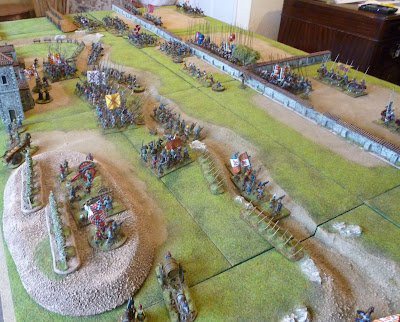 |
| A view of the fighting as it develops. |
 |
| The Spanish jinetes on the Spanish right flank begin to engage some of the French heavy horse. |
 |
| The Spanish left flank is being beaten back. |
 |
| During a skirmish attack by Spanish jinetes, the French general Louis d'Armagnac, Duke of Nemours is slain! |
Untroubled by the fact that their general had been slain the French infantry and light horse pressed home their attack on the Spanish centre. Leading the landsknecht in a counter attack across the ditch Fabricio Zamudio was slain by the Gascons. On the French left the heavy cavalry now moved into action. The jinetes who had killed Nemours were unable to evade a furious charge by the gendarmes and were quickly defeated. This in turn put some of the French heavy horse within range of the Spanish shot who opened fire on them. In an effort to avoid this fire and press home the assault the gendarmes rode into the Spanish men at arms who were waiting behind the fortifications. A chaotic cavalry melee developed and the already disordered French cavalry were defeated in the difficult terrain.
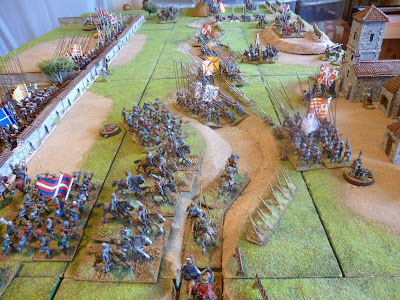 |
| A full on attack is launched on the Spanish infantry and landsknecht in the centre. |
 |
| In revenge for the death of their captain, the Duke of Nemours retinue charge down the jinetes. |
 |
| As the landsknecht launch a counter attack on the Gascons, their captain, Fabricio Zamudio, is slain. |
 |
| As Diego Garcia de Paredes arquebusiers begin to fire murderous volleys into the reisläufer, they are forced to attack the ditch. |
 |
| A view from above with the battle in full swing. |
 |
| The landsknecht briefly force the French assault back... |
 |
| ... only to be forced back by the weight of French numbers. |
 |
| A chaotic cavalry melee has developed between the Spanish men at arms and disorganised French gendarmes. |
 |
| The Spanish left flank has been completely turned. |
 |
| A view of the French attack on the ditch. |
 |
| As the Swiss attempt to force the ditch their numbers are thinned by the Spanish arquebusiers. |
Having lost their skirmishing arquebusiers to the Spanish guns the Swiss launched a charge on the Spanish position. They reached the ditch but suffered terrible casualties as this part of the Spanish position had not been involved in the duel with the Gascons and light horse. The Swiss were effectively stopped, causing little damage to the Spanish lines. This was to no avail as although the reisläufer had been checked by now the stradiots and Gascons were within the Spanish defences having broken through on the Spanish left.
On the Spanish right flank Prosepro Colonna lead his troops into Louis D'Ars gendarmes, defeating them and then rolling up the French heavy cavalry wing. This allowed de Cordoba and Colonna to escape with the Spanish men at arms in relatively good order, in fact not a single heavy cavalry unit had been lost. For the Spanish and landsknecht infantry it was a different matter. Yves D'Alegre and his cavalry swept into the Spanish position while Gaspard de Coligny's French infantry were also in relatively good shape. As the evening drew in some of the French guns began to arrive and it was clear that the field was theirs.
 t t |
| The Spanish have some luck on their right flank where Prospero Colonna leads a counter attack that pushes Louis D'Ars and his gendarmes back. |
 |
| The seigneur de Chandieus reisläufer force a way across the ditch despite suffering terrible casualties. |
This was a fascinating battle to refight and was not as one sided as I thought it was going to be, especially as once the surprise element of the ditch was removed it gave the French more options as to how to tackle the Spanish defences. With the French light horse and Gascons attacking first it really changed the nature of the fight, helped a lot by the chaotic nature of the rules! Having said that the Spanish shot behind and in the ditch were still really formidable and did manage to effectively wipe out the Swiss with them barely getting into any combat. With a few tweaks and special rules, such as the Spanish powder wagon blowing up as is reported in some accounts, this could be a game to visit again in the future.


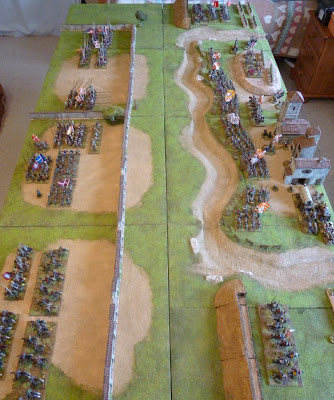
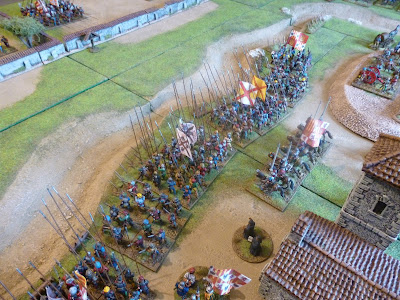

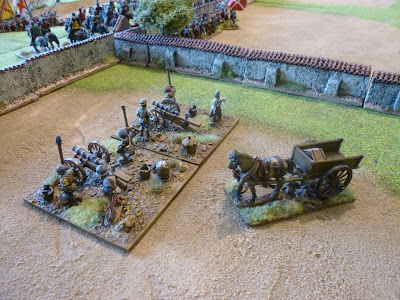
Thank you for a full and fascinating report. It certainly looks an action that's worth repeating and if you do, I'll be happy to read about it.
ReplyDeleteStephen
Cheers Stephen, it was fun to play through the battle and see the different result.
DeleteInteresting take on the battle, it's difficult because clearly the French should have attacked on the flanks but in reality they didn't, mainly down to the arrogance and hubris of both the French gendarmes and the Swiss who let's face it were pretty much undefeated up until this point using the frontal charge,it's almost as if you have to make the French charge frontally and still give them a chance of winning! Lovely looking game of course both your figures and the relatively new terrain!
ReplyDeleteBest Iain
Thanks Iain, yes that is exactly it, to get the historical result you have to have rules that will force the gendarmes and Swiss to attack head on. If not the French have plenty of other troops to allow for a more cautious, and effective, assault.
DeleteAnother spectacular and gorgeous (well, except for Fabricio Zamudio) game...Superb!
ReplyDeleteThank you Phil, yes Zamudio and of course Nemours both fared badly in this refight. Nemours wasnt taken out by an Arquebusier this time but by a Jinete right at the start of the battle.
DeleteSuper-looking game!
ReplyDeleteThank you, really glad you enjoyed it.
DeleteInspirational game! Thank you for posting this. I especially love your historical refights!
ReplyDeleteThank you John, I try and have as much historical reference as possible in the games, even if I am fighting a "what if" like all the de la Pole Tudor Rebellion games I have done.
DeleteBeautiful, simply beautiful. Ive never fought this battle so it was with real interest that I read your post. My understanding was that the French were suffering from poor morale due to the conditions and had become very lax.The Great Captain was able to maintain his mens morale and they clearly fought far better than the French,I was thinking of a small downgrade for the French.So well done.
ReplyDeleteThank you, I think the French morale was fine, certainly too high in some of the Captains and units, but yes discipline was certainly a problem and it was perhaps the discipline which meant the assault was so chaotic. I also wonder how much authority Nemours commanded over the other commanders, especially as, according to a lot of write ups, his caution was over ruled.
DeleteMore great eye candy oli, great terrain and miniatures.
ReplyDeleteCheers Chris, it was a fun bit of escapism to play through such a famous encounter.
DeleteExcellent AAR and beautiful armies too. This has always been one of my favorite periods. Great job!
ReplyDeleteCheers Joseph, I agree it is such a fascinating period especially the very early Italian Wars.
DeleteThat's a smashing read, wonderful photos too! A real treat!
ReplyDeleteThank you David, I am glad you enjoyed the pics and write up.
DeleteWonderful report and (as usual) excellent minis and terrain! Will steal the army order some time ... ;) Refighting historical battles are always a What-If-Scenario in some way or the other, and thats absolute OK in my opinion, as at the end of the day its a game with obvious a lot of fun involved! Fantastic!
ReplyDeleteThank you Michael -it was fun to play through. I would love to see your version of the battle on your blog if you do a refight of it.
DeleteYeah, I don't know if I got enough terrain atm (lockdown, club is down etc.) ... but its def on my list :)
DeleteGreat BatRep Oli and a difficult battle to set up and play but looks and sounds great. Enjoyed the read and pics. Cheers
ReplyDeleteCheers Hendrid - yes terrain wise it's a bit of a tricky one to game, the trench really is key, but the variety of troop types makes it a really interesting battle.
DeleteFantastic battle and figures Chris.
ReplyDeleteIve just been fighting Arquebus' board game of Bicocca. Its the same insane slog for the French - marsh then ditch and rampart. Did the French ever learn?
Stuart
Cheers Stuart - yes I have wondered that - it's nearly 2 decades later but it is funny how yet again it's pretty much the same scenario - and it's the Swiss who are keen for a headlong charge on the earthworks!
DeleteAn epic set up and great photographs. That terrain is so versatile.
ReplyDeleteThanks Stuart - we need to refight a few more of the big classics in the future - but at the moment I feel we are still recovering from the stress of the Agnadello game.
DeleteAbsolutely stunning battle Oli! Well done.
ReplyDeleteI'm sure you have this information somewhere on your blog, but what size is your gaming table?
Cheers Curt, it was a fun one to play through. I think the very early Italian Wars has a great mix of late medieval and early renaissance troops.
DeleteThe table is 8 foot by 4 foot.